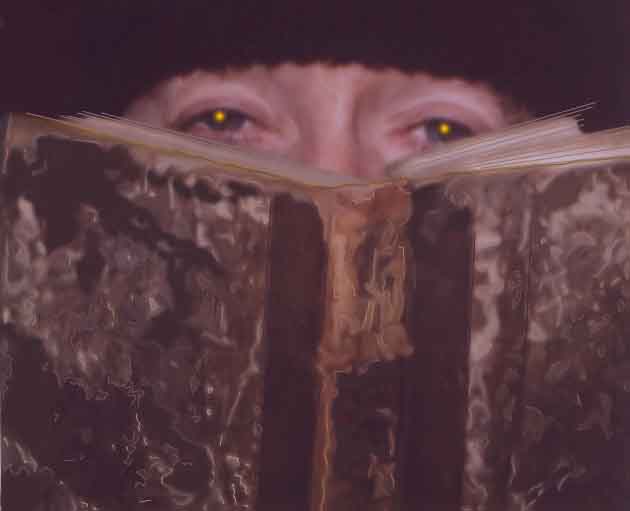









JAMIE BAXTER'S RECENT PAINTINGS
[First published as "Jamie Baxter" in Charlottetown, Prince Edward Island's Arts Atlantic 59, Fall/Winter, 6-7.]
A bear in a dress makes one wonder about what exactly is meant by the term "domestic animal." Baxter's animal paintings highlight the differences between the wild and the domestic in several ways. Kitchen cups have been painted around many of the animals, as if to emphasize the strangeness--for the animal, too--of a wild beast in a domestic setting. One of Baxter's bears is muzzled by a red strap, as if to reassure viewers that this circus animal cannot desert. In this painting, which like the others has no title, an overturned yellow kitchen cup is made as big as an animal trainer's prop, as if the bear has just jumped from it.
These paintings are beautifully made: they are rich and full of thick colour. The artist hasn't used a fauve technique to render his creatures--that might have been too obvious, having wild beasts painted in the manner of art historical "wild beasts" Matisse, Derain and Vlaminck. Thankfully, Baxter avoided such puns. Technically, one or two of the paintings reminded me of the painting of the early 1980s, except that Baxter paints better than most of the neo-expressionists.
A dog or a hyena is shown as a silhouette, a bit blurred, as if to emphasize the dark beastly side of the beast. One of the dog/hyena paintings sets itself apart from the bears because its setting is clearly not domestic, but unspecifically wild. This work marks the outer limit of wildness in the show, while a bear in a long red dress marks an inner limit of domestic buffoonery.
Baxter's muzzled bear is depicted in a cowering position, at the mercy of a master: humiliated. In addition to circuses, bear baiting, an ancient, cruel game, is recalled. But what exactly is cruel about putting a dress on a bear? A bear has little consciousness of why someone would find his dress amusing or entertaining.
A powerful creature brought under the thumb of a human gives some people sadistic pleasure. Baxter is not humiliating an animal, but depicting some imaginary humiliation. The carnivalesque operations of power in which a strong thing is mocked is simply presented.
However domesticized, a bear can still kill in one swipe, and so to see such. A certain violence prevents a reading of these paintings as illustrations for children's stories, although children certainly have access to the work on many levels. The knowing element of sadism, is adult: children, god love them, are capable of great cruelties without being aware of the moral depths they plum, but for adults, who rule over animals and children, the cruelty is a reminder not only of recent sins, but also of the unthinking crimes they committed as children. Children anthropomorphize animals the way adults imagine children as half-formed people, but children do not know this.
In the wider context of current media obsessions, Baxter's animals bring to mind domestic abuse and environmental damage as well as abuse of animals. All of this is conveyed through beautiful paint, which acts as the mediator and advocate of a viewer's troubles conscience. One of the images depicts a bear-like creature, but one which seems to be choosing whether it is a living thing or an undead toy. Upholstered in gray, this beast stares out hunched into an expression of desperate sentimentality. Kitchen cups hover obliviously around the gray head.

|
|